I currently share my life with two Siberian Huskies – puppy Lara (7 months old) and Shania (3.5 years old). Both of them are very silly, and very energetic. They love to play, explore, and hunt for earth critters.
Siberian Huskies are beautiful dogs who love people and love life. They can be great family dogs if properly trained. However, because of their high energy and high prey drive, they require a lot of daily exercise and are not to be trusted off leash. When bored, a Husky may chew, dig, and escape to look for adventure elsewhere.
Before getting a Sibe puppy, find out all you can about the wonderful nature of Siberian Huskies – the good, the bad, and the quirky.
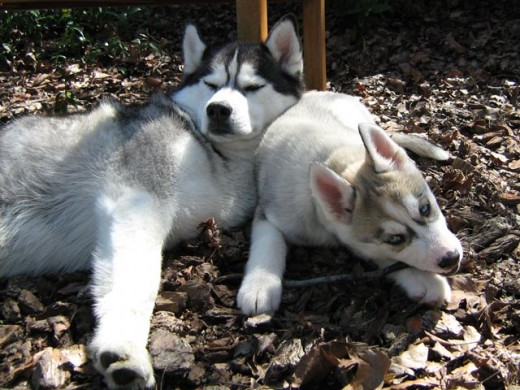
Siberian Huskies – The Good
1. Siberian Huskies are love bugs.
Sibes are very affectionate dogs. They are especially friendly with people, even strangers.
Husky Shania has very many friends in our neighborhood and she enjoys going to say hello to them every day. Her most favorite friend in the world is the Awesome Cookie Guy. Whenever we pass his house, Shania always stops and waits. When her Cookie friend spots her and comes out, he comes bearing gifts – a yummy low-fat cookie for Shania!
Shania also comes to me when I am sad or upset. She will lie down next to me or lay her head on my lap and give me licks.
The people trusting nature of Siberian Huskies make it easy to find caretakers for them when I get busy, or when I need to leave on emergencies or vacations.
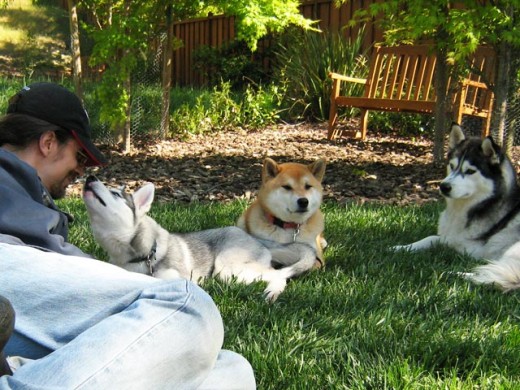
2. Siberian Huskies are athletic and have a strong zest for life.


Lara and Shania are frequently on the go. They enjoy re-landscaping our backyard, attacking bushes, pulling down trees, running, jumping, and digging. They both enjoy playing chasing games and are always ready to go out for a walk and explore. They get very excited whenever anybody comes to visit and enjoy spending play-time and rest-time with their pack.
As part of their zesty life program, Huskies also love to eat.
Both Lara and Shania will eat and eat and continue to eat more if they can. To keep them healthy and slim, I set up a fixed eating schedule and only give them their allotted amount of food. If I give them treats, then I reduce their regular meals a bit so that they keep a fairly constant caloric intake.
Sibes are not shy about stealing food or begging for food. Both Lara and Shania will steal each other’s food if they can. They will also steal from my other dog, Shiba Inu Sephy.
I always supervise them closely during meal-times. Food stealing can encourage food aggression, so I train my dogs not to steal and teach them that if there is any stealing, I will handle the situation.
Siberian Huskies can also get impatient about food and may get slightly overzealous when taking food out of your hand. Bite inhibition training is a must.
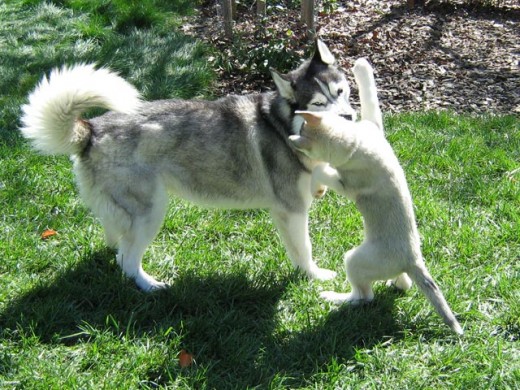
3. Siberian Huskies are clever and independent.
Reward Training
Sibes are smart and will quickly learn new commands and figure out interactive toy puzzles; especially when food is on the line.
Lara learned how to Sit on command as soon as we got her home (8 weeks old). In fact, if we use positive reinforcement techniques, we can start obedience training puppies as early as 6 weeks old. However, puppies should not be removed from the litter until they are at least 8 weeks old.
With clever and independent dogs like the Siberian Husky, it is most effective to use reward training techniques. I teach my Huskies that the best way to get what they want is to do what I want first. Here is more on how I trained my Husky puppy.

- If they want to go play in the backyard, they must first do a simple Sit next to the door.
- If they want their food toy, they must first do a Handshake.
- If they dig where they are not supposed to in the backyard then they lose their backyard privileges.
Since we control all of our dog’s resources, we can encourage good behaviors and discourage bad behaviors by tying those behaviors to our dog’s most desired resources.
With reward training my Sibes are always motivated to work. They are never hand-shy and love being with people. Siberian Huskies have a wonderful independent spirit, so we should not shock them, choke them, or physically dominate them into submission.

Siberian Huskies – The Bad
1. Siberian Huskies shed a whole lot.

Sibes blow their coat once or twice a year. During this time they will shed most of their undercoat and replace it with new fur. Frequent brushing will help to control some of this shedding and keep our Husky comfortable and clean.
Even though they may only blow their coat twice a year, Sibes actually shed all year round. There is Sibe fur everywhere in our house, including carpets, tile floor, counters, tables, chairs, blankets, and beds. Hair can also get onto kitchen utensils, food, and drinks.
Another issue to consider is pet allergies. Many people are allergic to dog or cat hair. Although Siberian Huskies have little doggy smell and are not one of the most allergy-causing breeds, a serious pet dander allergy of a family member should have you reconsidering a dog for your choice of pet.
~~[Siberian Husky Club of Canada]
Because they shed so much, try to make brushing and handling fun for your Husky. I always pair brushing sessions with food so that it becomes a fun and rewarding experience. I start with a soft brush and slowly switch over to using the Furminator which is awesome at getting out a dog’s undercoat.
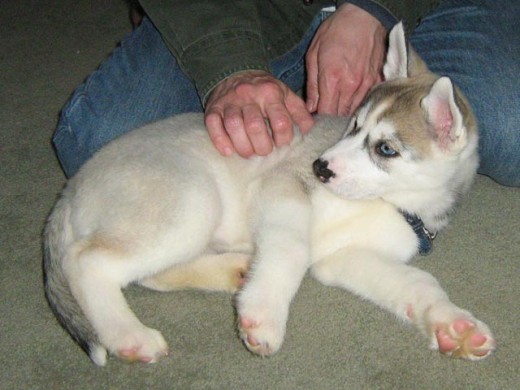
2. Siberian Huskies are awful guard dogs.

Sibes look wild, like wolves. For this reason, many people think that they make fierce guard dogs.
In truth, however, a Husky is more likely to invite strangers into your home with open paws and give them many licks.
Siberian Huskies are happy, goofy, and naturally trust all the people that they see.
My Siberians may sometimes make a fuss when people are at the door, but it is out of excitement rather than a warning cry.
Also, my Siberians will happily follow anyone home as long as they have some yummy pieces of food.

3. Siberian Huskies have very high prey drive.
Husky Shania is a very accomplished huntress.
When we first got our backyard landscaped, we had a big Earth Critter Attack. There are a fair number of rodents including gophers, voles, and mice that live in our area and they decided to throw a big party on our newly planted grass. Holes were appearing everywhere and the organic scent-based pest control we used did not seem to have much of an effect.
We were worried that our yard would not even last the year but then huntress Shania went into action. After a few days of hunting and marking, we noticed that the Rodent Gang had moved their party location somewhere else!
However, this high prey drive also makes it extremely risky to let a Sibe go off-leash in a non-enclosed space. If she spots a deer or squirrel, she will be gone and away before you can shout Stop. Siberian Huskies are very athletic and can cover large distances in a fairly short amount of time.
High prey drive also means that a Husky will have a strong instinct to chase and hunt cats and possibly also small dogs.

4. Siberian Huskies love to pull, pull, pull.


Sibes were bred to pull sleds, and today, they still love to PULL!
One of the biggest challenge with my Huskies is teaching them how to walk without pulling and/or to only pull on command.
The easiest way to leash train a Husky, is to start when she is young and still small. I have tried a variety of techniques with my dogs and what has worked best are the red-light,green-light technique and the 180-turn-around technique.
I started leash training puppy Lara almost as soon as we got her. First I trained her in our backyard. After she was fully vaccinated, I started leash training her around our neighborhood.
While leash training a Sibe, it is very important to be totally consistent. I stop as soon as puppy Lara starts to pull and if she pulls too much, I turn around and walk in the opposite direction. This teaches her that the fastest way to get to where she wants to go is to walk along with me at a measured pace.

5. Siberian Huskies love to sing.
Sibes have a great singing voice. However, neighbors may not particularly enjoy it when Siberians decide to sing or howl to the moon.
Husky Lara is a very vocal dog. She barks when excited, frustrated, scared, and sometimes when other dogs are barking. I have to spend more time and effort training her to stay quiet because her natural instinct is to vocalize.
Husky Shania is a more quiet dog. She almost never barks and the only time she vocalizes is when she is playing with my other dogs. She also sings beautifully when she hears a squeaky toy.
My Husky breeder tells me that there are some Sibe bloodlines that are more noisy than others. Lara’s mother, for example, comes from a more vocal bloodline.

6. Siberian Huskies are a big time commitment.

Sibes are very energetic and affectionate. They like being with people and they also need something to do. Otherwise, they will get bored and get into at least 10 kinds of trouble.
All my dogs work for all of their food, either through obedience exercises, grooming sessions, play sessions, or through interactive food toys. In addition, they go for 1.5 hour daily walks and wrestle with each other several times a day. Sometimes, I join in on the fun and play flirt pole or the water hose game with them.
When bored or lonely, a Husky will figure out her own activities, which may lead to property damage or escape expeditions.
Do not get a dog, especially a Siberian Husky, unless you have a lot of free time to spend with her. If you must work long hours, consider dog daycare or hiring a dog walker. Sibes do best when there are many interesting activities throughout the day and frequent human supervision.

I Love Siberian Huskies
Sibes are awesome dogs. They are always ready of adventure, and they will be there to give you licks and support when you need it, or even when you don’t.
I got my Huskies through the breeder list from the Siberian Husky Club of America. I also considered adopting from my local Siberian Husky rescue, but did not find one that fit well with my Shiba Inu.
It is best to avoid backyard breeders, pet stores, and online pet stores. Such establishments almost always sell unhealthy puppies with poor temperaments.
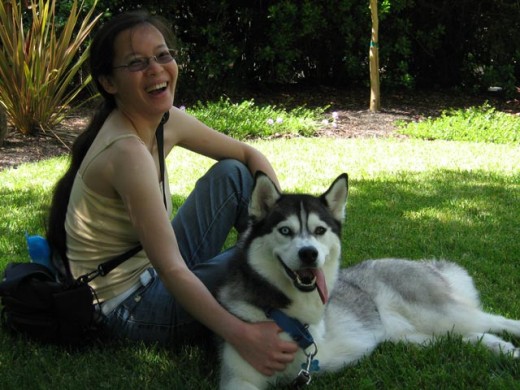
Source: Siberian Husky Pictures.
Congratulations on your new husky puppy!
“How can I teach her to be gentle with smaller dogs?”
Yeah both my Sibes also like to play rough. When I first got puppy Lara, I kept her on a leash (only with flat collar) while she was playing with my other dogs. This helps to keep excitement under control, and it also allowed me to stop her from playing too rough with my tripod dog Shania.
Every time she is too rough, I non-mark her (Ack-ack) and stop play. Then she has to do some obedience commands before play continues.
I still supervise my dogs during play and have lots of small breaks in-between so that things don’t get too energetic. Here is more on my experiences with introducing a new dog to my other dogs-
http://shibashake.com/dog/second-dog-introducing-a
As for recall training, what seems to work with my Sibes is to start small and then reward them really well when they come to me. I make sure they know I have some good food, then I just move one step away, call to them, make a bunch of noise, and move a lot. This will usually get puppy excited and want to move toward me. When she does, I make a big deal of it, and treat her very well. Sometimes I also play a fun game with her.
A common mistake that people make with recall training, is that they will call their dog to them and then punish him, or forcibly put him in his crate. This teaches a dog to stay away rather than come to us.
To get my dogs to come, I try to make sure that the recall command is ~always~ associated with something very positive, fun, and rewarding.
Hugs to Jade!
I recently got a husky pup she is now nine weeks old, she loves to play and run around and she is really smart already knowing how to sit lay down and come up on command, she even plays fetch already. I find it kind of difficult to keep her from being rough with my moms dog who is full grown and smaller than Jade. How can I teach her to be gentle with smaller dogs? also, I’m trying to teach her to come when I call, any suggestions?
Here are some of my experiences with biting-
http://shibashake.com/dog/puppy-biting-tips-solutions
i have an 10 week old husky it only takes someone to walk past him and he bites you really hard even when we play with him he seems to want to bite us instead of biting his bone or his toy how can i stop him biting
Hello Melissa,
1. Biting – What has helped with my Sibe puppies is bite inhibition training. Puppies usually start learning this from their mom and siblings. This is one of the reasons why breeders generally keep puppies together until they are about 8 weeks old.
http://shibashake.com/dog/bite-inhibition
At the same time, I also teach them not to bite on people. Here is what I do –
http://shibashake.com/dog/how-i-trained-my-husky-puppy#bite-training
2. Potty training
A big part of potty training depends on what the puppy is used to at the breeders house. Some breeders potty train their puppies, some let puppies go on puppy pads, and sometimes, puppies are just left with their business without clean-up. The last group will take more effort to potty train.
With my Sibe puppy Lara, supervision was really very important. I had to supervise her all the time when she is roaming around the house. If I don’t have time to supervise, I tether her in the kitchen. As soon as it looks like she is about to go, I take her outside. If she starts to go, I interrupt her and take her outside for her to finish. Then I praise her a lot, treat her, and play a really fun game with her.
With puppy Lara, I found that she really needs to pee after short amounts of play-time. I usually take them out after about 10-15 minutes of play. I also take her out when she wakes up. When she has been outside for a while and wants to come in, I usually take her to her potty spot first, and remind her to potty, just in case she needs to. Then she comes in.
Here is more on my potty training experiences-
http://shibashake.com/dog/puppy-potty-training-facts-and-myths
3. Food Aggression
It is important to train a puppy not to be food aggressive. My Sibes are very food focused so I did a fair amount of food exercises with them when they were puppies.
http://shibashake.com/dog/stop-food-aggression-stop-resource-guarding
Here are a few extra things that helped me a lot while bringing up a puppy-
http://shibashake.com/dog/puppy-obedience-training
we recently got a Husky puppy. She was six weeks when we got her and we have had her for just over 4 weeks. I have several concerns.
1: I have 3 kids. They are 12, 3, and 6 months. Our puppy Kovey is extremely aggressive with them and us. She constantly bites and to be honest she has drawn blood, even on our 6 month old. I have told her “no” sternly, but she just doesn’t stop. My 3 year old is to the point that he is scared of her and I am getting extremely frustrated. We can’t even pet her with out her growling and lunging for our faces and hands.
2. She will not get house broken. I understand that we’ve only had her for a short time and that its not going to happen over night but what I don’t understand is, she will be outside playing for a half hour and the minute she comes in she makes a mess. Also, she will go 4 or 5 times in a very short amount of time. She does not attempt to let us know that she has to go and only whines after its done. Once again, I tell her thats naughty and I usually put her back outside but sometimes I put her in her kennel for a few minutes. She does not like to be by herself and I was hoping that she would put the two together.
3: When she is eating, if my kids even go by her, she starts to growl.
I guess what im asking is if I need to worry about my children? I realized that I should’ve researched Husky dogs but I went off of the word of the person I bought her from. What do we do to stop the biting and how do we get her house trained? Are they normally house trained by 10 weeks? I have no idea what we’re doing wrong. When she does go outside I make sure I reward and tell her she what a good dog she is. Also,Im concerned that the bigger she gets the more aggressive she is going to be and the harder she is going to bite. Obviously my kids are my first priority and I need to make sure they are going to be safe. My husband tells she is just being a puppy and she will grow out of it, but im not so sure. Any advice would be greatly appreciated! Thanks so much!
“how to teach a Siberian to give paw? what gestures should I do and when should I reward?”
With puppy Lara I first got her to do a Sit. Then, I just said “Paw” and then lifted her paw. Then I praise and treat. I repeat this a few times.
Then I say “Paw” and just put my hand there next to her paw, but I don’t lift it. If she lifts the paw on her own, I make a really really big deal out of it, and give her a big bonus reward. Then I repeat a few more times and do something else before she gets bored.
If she does not lift the paw after a certain duration, then I go back to lifting the paw and reinforcing the behavior with rewards. I make sure to stop before she gets bored so that she is always interested in working and doing commands.
Add: In terms of the nippiness, what has worked with my Sibes is bite inhibition training.
http://shibashake.com/dog/bite-inhibition
Hello Nadia,
Congratulations on your new Sibe puppy!
In terms of the eating, what seems to work well with all my dogs is to make them work for all of their food. I use their regular kibble rations for obedience training, grooming, play, and socialization. If there is food left over, I put them in interactive toys so they have to work for that too.
Interactive toys are great because it not only exercises a dog mentally, but it also controls the speed at which they can eat the food.
Here are some of my experiences with interactive food toys-
http://shibashake.com/dog/best-dog-toys
Frozen Kongs are good, and I also like the Premier Busy Buddy toys. Always be careful to supervise and make sure the toy is safe and not a choking hazard.
Hello Jennifer,
“As in, do they need constant supervision while at home? Or can you off and do your own thing for a bit?”
With Shania and Lara, I can definitely do my own thing. As long as they get a nice walk every day (I am currently walking them for about 1.5 hours), they are pretty good about keeping themselves occupied for most of the day. During puppy-hood though, I had to keep a much closer eye on them.
http://shibashake.com/dog/a-new-puppy-first-10-day
I have a section in the backyard that is not landscaped, and they dig there for earth critters. They also play chasing games with each other, and sometimes I throw some kibble for them and they have fun searching for it in bushes, etc. They also have chew toys outside, and they will also pull down branches from trees and bushes to chew on.
I am usually home, so I look in on them from time to time. Sometimes they catch a mouse or bird, and I don’t really want them eating it. Otherwise, I have left them home alone for about 2-3 hours at a time. I did not do this until puppy Lara got a bit older, bigger, and a bit calmer.
I am probably more on the “helicopter-parent” side though. 😀 Part of this is because Shania is a three legged dog so I want to make sure the other two dogs do not overwhelm her.